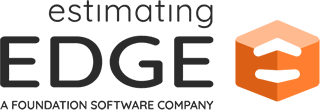 Estimating Edge’s team of experienced construction professionals and software engineers have developed the industry’s smartest takeoff and estimating software solutions for competitive estimates.
Estimating Edge’s team of experienced construction professionals and software engineers have developed the industry’s smartest takeoff and estimating software solutions for competitive estimates.
Don’t just estimate faster. Estimate better.®
- /
- /
- /
Items Screen
Customize Columns | Items List Screen
Overview:
To customize your database columns, select Edit | Customize Columns. Doing so will open a Customize list of headings that you have not included.
– ![]() Indicates a line or lines have been marked.
Indicates a line or lines have been marked.
– ![]() Tells you a note exists for this screen, if you do not know what it is – you should read it.
Tells you a note exists for this screen, if you do not know what it is – you should read it.
– ![]() Errors are present on the current screen, look at the Troubleshooter bar for hints as to the problem.
Errors are present on the current screen, look at the Troubleshooter bar for hints as to the problem.
# – The # sign tells you how many lines are on a given screen.
Description – A Description of the line the cursor is on in the current screen.
Item Code – A unique code that identifies every line in every database, the can be no duplicates.
From – Tells you where the Condition is getting its quantities from, they are: Measured, from another Condition or Entered. You an also override measured Conditions.
Quantity – Displays the measured or entered quantity for the line.
Order Qty – The amount of the item you need to order to complete the work.
Order Qty Add – Allows the user to add a specific number to an order unit.
Alt Qty – Allows you to create a second or alternate method for quantifying, ordering and pricing items.
Unit Price – How much you will pay per unit for an item.
Sell Price – How much you will sell an item for.
Total Price – The cost for all occurrences of an item in an estimate.
User Code – A user code is how the program determines what general category heading an item gets listed under for reports. The EDGE uses a modified version of the CSI (Construction Specification Institute) Uniform System. The EDGE use the standardized 16 divisions. If you are a roofing contractor for example you will find that your user code goes from 07-100-000 to 07-999-9999. The same holds true For other users of The EDGE.
CQty – The way the labor, material and miscellaneous is calculated for that condition.
Alt CQty – An alternate way the labor, material and miscellaneous is calculated for that condition.
EU – This represents the cost incurred to the job divided by the Estimated Unit.
AU – Allows you to create a second or alternate method for ordering and pricing items.
Cost/EU – How much an item will cost you per unit.
Order Un – The descriptor you plan to use when ordering the item.
Prc Un – The descriptor you plan to use to price the item.
Price Qty – Adjusted pricing quantity.
Pricing Date – The manufacturer’s price per dated sheet.
Hours – The number of hours required to complete the work .
Mandays – The number of Mandays required to complete the work.
Crewdays – The number of days a crew is needed to complete the work.
Crew Size – The number of workers that make up a given crew.
Order Formula – Converts an item from estimated units (SF, LF, EA) to order units (Rolls, Tubes, Cases, Tons).
Price Formula – If the price unit differs from the order unit, a secondary formula called the price formula will convert them item for you i.e. an item is priced by the roll but you have to order by the carton.
Prod Rate – This is the amount of work you can get done for a material item in a given amount of time.
Tax Class – This classifies the type of expense for this item as one of the Tax Classes (Labor, Material, Subcontract, Equipment and Other).
U Ord Qty – Adjusted order quantity.
Account Code – Displays the account code for the line the cursor is on if applicable.
Phase Code – Displays the phase code for the line the cursor is on if applicable.
Part Number – Displays the Part Number for the line the cursor is on if applicable.
Waste % – The individual percentage of waste you added to an item.
Waste Qty – This is the result of the quantity number multiplied by the waste percent.

